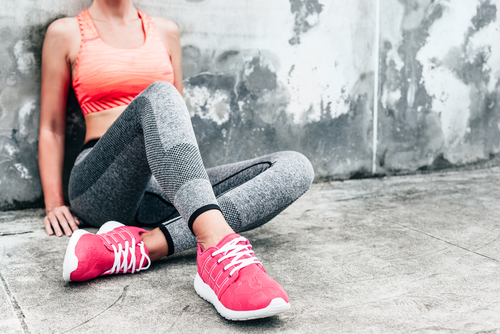How textile brands are responding to shifting consumer priorities

Hologenix’s Stephen Kelly explains how apparel retailers and textile brands can get new products to market that tap into changing consumer priorities such as self-care, fitness and sustainability.
Apparel consumers typically don’t shift their buying priorities drastically, explains Stephen Kelly, textile material science company Hologenix’s VP of International Business and Supply Chain. He explains that generally, their priorities evolve slowly enough for retailers and textile brands to keep up. However, the pandemic and concurrent social unrest set the stage for a major pivot in what matters to shoppers. And brands have no choice but to sprint to stay on top of all the changes.
Management consulting company McKinsey noted this widespread phenomenon. The piece focused mainly on sustainability, a topic that has certainly increased in importance for consumers, but it broadened its scope into more specific areas like ethical sourcing and safety. Yet greenness is by no means the only consideration driving people from all generations to support one brand over another. Here are a few others that have emerged:
- Social justice: Like environmental concerns, consumers are paying more attention to the costs of products — and it’s not about the sticker prices. Consumers want to support brands that have social policies they believe in, and they want brands to be transparent. For example, consumers want to know that their garments have been created with fair labour standards when it comes to textiles.
- Health and wellness: The pandemic emphasised health and wellness through self-care. Many customers want to be more active, eat healthier, and improve their sleep. Consequently, they’re looking for brands and items — like smartwatches or tech-buoyed mattresses — that will help them achieve those goals.
- Utility in the new normal: Buyers from all age groups are eager to get the most out of everything they invest in. Athleisure is the name of the game in the new normal. People want clothing they can wear to work, exercise in, and then come back to work without changing.
These needs can’t and shouldn’t be ignored by retail and textile ingredient brands. The brands that are carefully listening to consumers will capture attention and loyalty. They’ll also be more likely to be perceived as innovative industry leaders authentically aligned with customers’ values.
How brands can overcome stumbling blocks toward giving consumers what they want
Why aren’t all retailers and brands entering a massive problem-solving mode that keeps them hyper-focused on consumer trends? Many haven’t realized that these trends are more than fads that will dissolve or fade. The pandemic gave people the rare opportunity to take inventory of what matters most to them. Now that they’ve identified their priorities, they’re not about to abandon them.
Take the self-care trend, for instance. The wellness market is booming, and a Vagaro study indicates that around seven in ten people expect self-care to become a societal norm by 2026. This means there’s a wide opening for pragmatic retailers and brands to build legitimacy by offering unique, diverse single products and product lines that support self-care.
Some retailers have already done this by partnering with advanced ingredient brands made to enhance textiles. Most textile-based brand ingredients foster mechanical changes like protecting the wearer from sun exposure or wicking away moisture.
On the other hand, advanced smart textiles rely on ingredient brands to do much more. Who would imagine that a garment could convert the body’s heat into usable infrared energy that could help the wearer improve local circulation and increase cellular oxygenation? Yet it’s being done. And it’s attracting the attention of a consumer market intrigued by the possibility of getting health and wellness benefits from apparel — the same consumers who have already sought out vitamins and supplements for improved overall wellbeing.
Brands can build partnerships to accommodate the latest consumer pivots
Retail and textile brands can’t meet all the different consumer priorities overnight. They must re-evaluate many parts of their processes and form partnerships. Additionally, they must deal with the realities of a broken supply chain system.
Below are some methods for retailers and brands to apply to get new, exciting products to market faster and capture consumers’ attention.
1. Diversify supply chains to limit interruptions.
Retail and textile ingredient brands that have been hardest hit by supply chain issues and shipping delays tend to be those that source from only one country or supplier. The answer to unravelling this tangle is to diversify their supply chains. In McKinsey’s “State of Fashion 2022” report, apparel companies report turning to in-store supply stocking, nearshoring, and agile operating models to alleviate the burden of supply chain hiccups.
Diversification naturally opens the door to alternate options. It also reduces risks associated with not being able to securely or adequately meet customer needs when intent runs highest.
Having different sources geographically provides a contingency plan if any supply chain issues arise. Start building alternate regional manufacturing options outside your usual source, starting with lower-risk product lines or categories that you can then scale up as needed.
It’s challenging to compete with labour costs in other countries on the domestic front. Look into manufacturers that use less labour-intensive manufacturing methods, such as engineered knitting machines. Although it is a common belief that US manufacturing is too expensive or lower quality, there are a lot of manufacturers that use engineered knitting machines that create high-quality products.
Consider different certifications, such as Fair Trade Certified manufacturers, when looking into different options. When consumer expectations shift, having a network of manufacturers with various sustainability certifications can help you be ahead of the curve so you don’t need to start from scratch.
2. Expand marketing strategies to appeal to new audiences.
One of the side effects of changing consumer preferences is a chance to serve a different target market. Consider how the fitness industry has morphed and grown. Today, demand for integrated accessories that measure and monitor everything from oxygen levels to heart rates is high, and not just in the consumer marketplace.
Healthcare providers are becoming interested in ways to integrate the use of self-care apps for telemedicine and virtual healthcare purposes. Similarly, some hospitals are experimenting with clothing made from smart fabrics to see if those garments can improve patient comfort or outcomes.
One way you can discover new audiences is by understanding generational priorities. Baby Boomers, Millennials and GEN Z all have different priorities. If you can understand what problem your company is solving for each demographic and adjust your marketing to fit your segments accordingly, you can experiment with attracting new audiences.
3. Choose greener suppliers willing to go above and beyond.
Consumers are doing their research to ensure that retail and ingredient brands stay true to their stated beliefs, including mapping out supplier routes and determining how eco-friendly a supplier footprint may be.
Today, consumers witness news images of gas-guzzling trucks and boats crisscrossing the planet. They’re asking brands to find more environmentally conscientious ways to take products from raw materials to sale. One approach is picking small, localised manufacturers over larger ones for their speed, efficiency, and reduced carbon emissions.
Inform your audience about your sustainability measures by sharing promotional content, including branded blog posts, social media posts, and emails. Engage with customers by sharing sustainability initiatives, certifications, or awards that the retail brand, ingredient brand, or manufacturer receives.
In brick-and-mortar settings, hangtags and point-of-purchase displays can highlight sustainability certifications like Fair Trade Certified, biodegradable, or recycled materials.
4. Pay attention to emerging consumer trends and lateral moves.
What’s trending today among consumers may not be trending in the same direction tomorrow. Though current trends have gotten a foothold, they will expand and develop over time. Brands that pay attention to what’s coming next won’t be surprised when consumers make lateral or vertical shifts.
Although consumers are willing to pay more for high-quality, sustainable products, they want to spend less on them overall. Consequently, brands need to prove that their products have value while still looking for ways to compete on price.
You can prove value to customers by proactively meeting their expectations and getting ahead of potential concerns. Anticipating your customers’ needs and innovating solutions to improve your product and alleviate negative environmental impacts builds customer loyalty and brand credibility.
5. Announce and back initiatives that support meaningful actions.
Consumers have expectations that all brands, including retailers and textile ingredient brands, will make sincere efforts to become good stewards of the environment. And they’re willing to call out companies with disingenuous sustainability marketing practices. Therefore, brands should make and advertise their plans to take action.
For instance, Apparel brand X might announce a goal to only use natural and biodegradable fabrics by 2025. The goal becomes a key differentiator and unique selling proposition, as long as it’s clear and attainable.
Meeting the needs of a marketplace that has made what feels like a 180-degree shift can seem overwhelming. Nevertheless, retail and textile ingredient brands must respond to what consumers need and want at the moment. Those who do will see a payoff in brand recognition, loyalty and profits.
Stephen Kelly is the VP of International Business and Supply Chain for Hologenix, a materials science company dedicated to developing products that amplify human potential and improve health and wellness. CELLIANT®, its flagship technology, is an infrared ingredient brand that enhances textile-based products with health and wellness benefits across performance, recovery and sleep. CELLIANT’s natural blend of IR-generating minerals is embedded into fibers, yarns and fabrics, powering bio-responsive textiles utilized by world-class brands in products spanning apparel, sleepwear, bedding, upholstery, uniforms and medical supplies. Stephen has over a decade of experience in sports apparel product development, and deep knowledge of international supply chain dynamics. This article was originally published on JustStyle.com.



